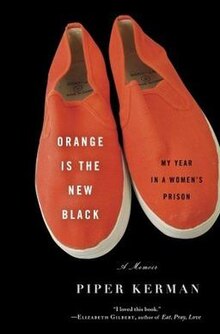Orange Is the New Black: My Year in a Women's Prison
 | |
| Author | Piper Kerman |
|---|---|
| Language | English |
| Genre | Memoir |
| Published | 2010 |
| Publisher | Spiegel & Grau |
| Publication place | United States |
| Pages | 327 |
| ISBN | 978-0-812-98618-1 |
Orange Is the New Black: My Year in a Women's Prison (titled Orange Is the New Black: My Time in a Women's Prison in some editions) is a 2010 memoir by Piper Kerman, which tells the story of her money laundering and drug trafficking conviction and subsequent year spent in a federal women's prison.[1]
The book became the basis of the Netflix original series Orange Is the New Black.[2]
Background
Early involvement
The memoir details the events which occur as a result of Piper Kerman's involvement with Nora Jansen, a former friend, lover and drug smuggler. In 1993, shortly after her graduation from Smith College, Kerman agreed to accompany Jansen on several trips to Asia and Europe, going as far as carrying a suitcase of laundered money across the Atlantic Ocean before returning to San Francisco to “piece her life back together”. In May 1998, Kerman was visited by two Customs agents, and six years later she was sentenced to 15 months in federal prison. After serving time in three different facilities (FPC Danbury, FTC Oklahoma City, and MCC Chicago), Kerman was released in March 2005.
Alhaji
This case has remained open for over two decades, and “Alhaji” has never been prosecuted. One suspect indicted in 1998 – Prince Buruji Kashamu – was initially pursued by US DEA officials as the suspected leader of the illegal operation Kerman joined in the early 1990’s. The government of the United States has sought the extradition of Buruji Kashamu, a Nigerian businessman and politician, alleging he led the drug ring Kerman was involved in along with drug trafficking charges. Kashamu has stated that he is innocent and that the drug ring was run by his brother, Alhaji Adewale Kashamu. Kashamu was exonerated of all charges after standing trial in London, England. He was detained in 1998 at City Airport London when officials discovered a US warrant for his arrest. Kashamu then stood trial twice to clear his name. Both the Bow Street Magistrate Court and the English High Court Queens Bench Division in London determined that the man the indictment was targeting was truly Kashamu’s brother. The charges against Kashamu had been a case of mistaken identity and Kashamu was exonerated in 2003.[3][4]
Reception
This section needs expansion. You can help by adding to it. (July 2014) |
Sasha Abramsky of the Columbia Journalism Review stated that the book "documents the author’s attempts to preserve her individuality in the face of a gray, impersonal bureaucracy—one based around prisoner counts, strip searches, rules governing the minutiae of life, and continual reminders that prisoners, by definition, have no power, no real autonomy."[5] Abramsky wrote that the book is mostly "a journey of self-discovery, describing how one can find one’s true strengths during moments of adversity" and that it "is more similar to South African anti-apartheid activist Albie Sachs's Jail Diary than it is to, say, Mumia Abu-Jamal’s denunciatory communiqués from Pennsylvania’s death row."[6]
In her review for Slate, Jessica Grose argued that the book is not an examination of women within prison but rather a member of the middle-class-transgression genre, in which women from higher level social classes go into situations which are considered degrading. She said that the book should have included Kerman's insight into her own behavior and "A bit of this moral ambiguity would have helped Kerman's memoir a whole lot."[7] June Thomas, also from Slate, cited Grose's review and stated that, "Ultimately, though, the book feels like a well-written, readable stage in Kerman’s rehabilitation."[8] Thomas stated that the television show had improved on the book by expanding on Kerman's descriptions of real people and turning them into compelling fictional characters.[8]
The book was selected by the UC Santa Barbara Library as its 2015 book for the university-wide reading program "UCSB Reads".[9]
See also
References
- ^ Humphrey, Michael (March 25, 2010). "Ex-Convict Piper Kerman on Her Hot New Memoir, Orange Is the New Black". New York Magazine. Retrieved May 8, 2010.
- ^ Lee Ball, Aimee (August 2, 2013). "Prison Life, Real and Onscreen". The New York Times.
- ^ Heinzmann, David (July 6, 2014). "'Orange Is New Black' Drug Case Still Open in Chicago Federal Court". Chicago Tribune. p. N.p., 14.
- ^ Richard, Allen (October 27, 2000). "'Man Kept in Jail 2 years in US extradition case.' The Evening Stand". London Tribune.
- ^ Abramsky, Sasha. "American Justice." Columbia Journalism Review, May–June, 2010, Vol.49(1), p.55(3) [Peer Reviewed Journal]. Online: May 1, 2010. Online p. 3. (Archive). Retrieved on July 9, 2014. "The juxtaposition between Texas Tough and Orange Is the New Black is fascinating, and makes them well worth reading together."
- ^ Abramsky, Sasha (May–June 2010). "American Justice". Columbia Journalism Review. Vol. 49, no. 1. pp. 55(3). Retrieved July 9, 2014.
- ^ Grose, Jessica. "What's a Nice Blonde Like Me Doing in Prison?" Slate. April 8, 2010. Retrieved on April 10, 2016.
- ^ a b Thomas, June. "How Orange Is the New Black Improves on the Book." Slate. July 22, 2013. Retrieved on April 10, 2016.
- ^ Estrada, Andrea (November 24, 2014). "'UCSB Reads' Selects 'Orange Is the New Black' by Piper Kerman". The UC Santa Barbara Current. Retrieved January 14, 2015.
